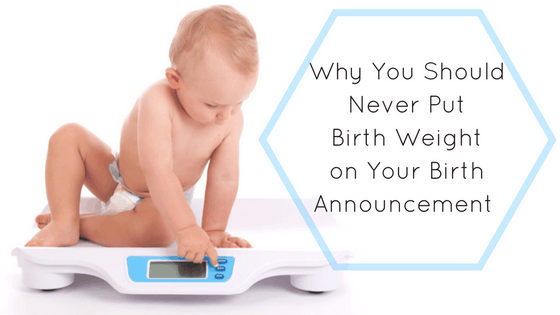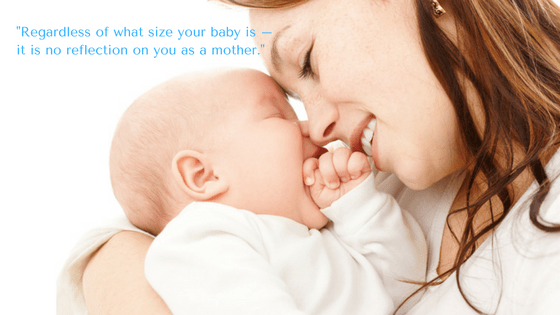

Our country is obsessed with weight. All those crazy weight loss shows make my point. Sadly, this obsession includes out babies. Literally – from the moment of
birth, the #1 question is “how much does he weigh?” Birth weight is always listed on the birth announcement, and even strangers in the store will ask you how big your baby was when they were born.
Any medical professional will also want to know “what percentage weight did he lose in the hospital?”“how much did he gain by his 2 day check-up?” and “When did he return to his birth weight?. I bet you know that answer to all those questions, don’t you!?
I’ve even hear parents refer to their well-baby pediatrician’s visits as weigh-ins. They weren’t joking. When you have a baby, it does feel like your doctor is more of a Weight Watcher’s counselor than a doctor – it’s all about the scale. I am a doctor myself and I understand that weight is the best metric we have … but we’ve become obsessed!
Mothers especially become emotionally attached to the weight and size of their baby and take growth rates as reflections on their personal parenting performance.
This is not good for many reasons. First – we have become obsessed with the “bigger is better mentality” among our babies and that’s not really true.
I know you ALL can imagine one of your friends beaming about their little one with pride saying, “That’s my 85th percentile boy!”
You also ALL know someone who seems to be ashamed of the fact that her baby is smaller and will apologetically say “he’s only in the 20th percentile”.
We’ve become so obsessed that our perceptions of what is “big” and what is “normal” and what is “healthy” have all become skewed – and it’s causing parents a lot of anxiety!! I hate that! Parenting is hard enough without completely unnecessary anxiety.
So I’m going to go over a few pure facts to help us better define “normal”…
Birth Weight
In medical research, we define a “normal” birth weight as between 2.5 and 4.0 kg – That’s between 5 lbs, 5 oz and 8 lbs, 13 oz. This is for a term infant (so born after 37 weeks).
If your baby was born before then, a smaller birth weight is expected. This means 10 pound babies (which are admittedly becoming more common) are NOT “normal”! I feel horrible when mothers tell me “He was only 6 pounds 8 ounces at birth” with this look of devastation and guilt. Girl! You did a great job growing that baby!
Really big babies (like 10 pounds) are at risk for their own medical complications, just like really small babies are. And regardless of what size your baby is – it is no reflection on you as a mother. Do you love, cherish, kiss, and care for your baby? Then you are a good mother! We’ve got to drop the obsession with birth weight.

Growth percentiles
Here’s the deal on percentiles (those curvy charts the pediatrician shows you at each visit). For the first 2 years of your baby’s life, your doctor will chart your baby’s length and weight on a percentile chart that is based off of a huge study done by the World Health Organization.
This study followed thousands of exclusively breastfed babies all over the world, and published that curve which shows how all those babies grew on average. Here’s how to interpret a percentile :
- The 50th %ile = 50% of normal healthy babies will naturally be below this number.
- The 10th %ile = 10% of normal healthy babies will naturally be below this number.
- The 90th %ile = 90% of normal healthy babies will naturally be below this number.
In other words, the same number of infants will naturally be at the 90th %ile, and the 10th %ile. That amount is 10% of all infants. Percentiles are NOT like grades – 50% is the literal average – it is not failing. 90% is NOT winning – it means that 90% of healthy breastfed babies are smaller than that.
Another fact: Formula fed babies gain weight faster in the first few months than breastfed babies. This means if you are breastfeeding you should expect your baby to grow a bit slower than your girlfriend’s baby who is formula fed.
Another fact: A single percentile from one point in time is a worthless number. Percentiles are only useful medically when plotted over time. As explained above, a weight at or below the 35%ile is perfect for about 35% of healthy breastfed babies.
What we care about is how your baby grows over time. Does he continue to stay around the 35%ile (maybe somewhere between the 20th and 50th)? That’s what is healthy. We don’t want to see a baby moving down OR UP a percentile curve too much. If a baby starts at the 50th and continues to drop and ends up at the 5th percentile 4 months later – that may indicate a problem.
IN THE SAME WAY – a baby who starts at the 20th and ends up at the 65th percentile is also growing too quickly. It’s just that no one seems to care if baby’s grow UP a curve. But all these numbers are symmetrical around the 50th percentile. Its just our “bigger is better” culture that has misplaced value on the top 50% of the growth curve.
So to end this article, here’s what I wish for you, and our culture.
- I wish pediatricians and medical professionals put less obsessive-emphasis on weight and took into account other factors like the baby’s genetics, general health and appearance, and behavior, etc.
- I wish our culture stopped comparing infants’ weights at birth and putting it on birth announcements – it’s just not fair to mothers who will always take it personally.
- If we can re-educate people about what a percentile actually is – and how it should be used – then maybe we’ll stop this cycle of “nervous weigh-ins”.
Knowledge is always power. I hope this article helps you separate your worth as a parent from your child’s weight. Let’s stop obsessing about the scale and just celebrate that little angel!
All my best,
xo Dr. Young


Leave a Reply